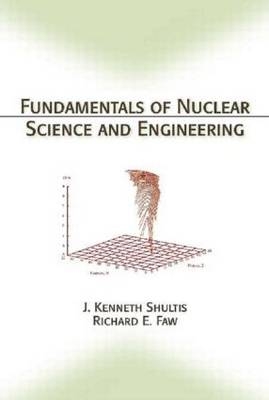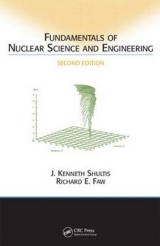
Fundamentals of Nuclear Science and Engineering
Marcel Dekker Inc (Verlag)
978-0-8247-0834-4 (ISBN)
- Titel erscheint in neuer Auflage
- Artikel merken
Fundamentals of Nuclear Science and Engineering provides an ideal introduction to the subject. The first half of the text reviews the important results of "modern" physics and introduces the fundamentals of nuclear science. The second half introduces the theory of nuclear reactors and its application in electrical power production and propulsion. It also surveys many other applications of nuclear technology encountered in space research, industry, and medicine. Each chapter contains extensive problem sets, and appendices at the end of the text furnish large amounts of practical data that enable students to perform a wealth of calculations.
Among the myriad concepts, principles, and applications addressed in this text, Fundamentals of Nuclear Science and Engineering
Describes sources of radiation, radiation interactions, and the results of such interactions
Summarizes developments in the creation of atomic and nuclear models
Develops the kinematics and energetics of nuclear reactions and radioactivity
Identifies and assesses biological risks associated with ionizing radiation
Presents the theory of nuclear reactors and their dynamic behavior
Discusses the design and characteristics of modern nuclear power reactors
Summarizes the nuclear fuel cycle and radioactive waste management
Describes methods for directly converting nuclear energy into electricity
Presents an overview of nuclear propulsion for ships and space crafts
Explores the use of nuclear techniques in medical therapy and diagnosis
Covers basic concepts in theory of special relativity, wave-particle duality, and quantum mechanics
Fundamentals of Nuclear Science and Engineering builds the background students embarking on the study of nuclear engineering and technology need to understand and quantify nuclear phenomena and to move forward into higher-level studies.
FUNDAMENTAL CONCEPTS
Modern Units
The Atom
Chart of the Nuclides
MODERN PHYSICS CONCEPTS
The Special Theory of Relativity
Radiation as Waves and Particles
Quantum Mechanics
Addendum 1: Derivation of Some Special Relativity Results
Addendum 2: Solutions to Schrodinger's Wave Equation
ATOMIC/NUCLEAR MODELS
Development of the Modern Atom Model
Models of the Nucleus
NUCLEAR ENERGETICS
Binding Energy
Nucleon Separation Energy
Nuclear Reactions
Examples of Binary Nuclear Reactions
Q-Value for a Reaction
Conservation of Charge and the Calculation of Q-Values
Q-Value for Reactions Producing Excited Nulcei
RADIOACTIVITY
Overview
Types of Radioactive Decay
Energetics of Radioactive Decay
Characteristics of Radioactive Decay
Decay Dynamics
Naturally Occurring Radionuclides
Radiodating
BINARY NUCLEAR REACTIONS
Types of Binary Reactions
Kinematics of Binary Two-Product Nuclear Reactions
Reaction Threshold Energy
Applications of Binary Kinematics
Reactions Involving Neutrons
Characteristics of the Fission Reaction
Fusion Reactions
RADIATION INTERACTIONS WITH MATTER
Attenuation of Neutral Particle Beams
Calculation of Radiation Interaction Rates
Photon Interactions
Neutron Interactions
Attenuation of Charged Particles
DETECTION AND MEASUREMENT OF RADIATION
Gas-Filled Radiation Detectors
Scintillation Detectors
Semiconductor lonizing-Radiation Detectors
Personal Dosimeters
Measurement Theory
RADIATION DOSES AND HAZARD ASSESSMENT
Historical Roots
Dosimetric Quantities
Natural Exposures for Humans
Health Effects from Large Acute Doses
Hereditary Effects
Cancer Risks from Radiation Exposures
Radon and Lung Cancer Risks
Radiation Protection Standards
PRINCIPLES OF NUCLEAR REACTORS
Neutron Moderation
Thermal-Neutron Properties of Fuels
The Neutron Life Cycle in a Thermal Reactor
Homogeneous and Heterogeneous Cores
Reflectors
Reactor Kinetics
Reactivity Feedback
Fission Product Poisons
Addendum 1: The Diffusion Equation
Addendum 2: Kinetic Model with Delayed Neutrons
Addendum 3: Solution for a Step Reactivity Insertion
NUCLEAR POWER
Nuclear Electric Power
Pressurized Water Reactors
Boiling Water Reactors
New Designs for Central-Station Power
The Nuclear Fuel Cycle
Nuclear Propulsion
OTHER METHODS FOR CONVERTING NUCLEAR ENERGY TO ELECTRICITY
Thermoelectric Generators
Thermionic Electrical Generators
AMTEC Conversion
Stirling Converters
Direct Conversion of Nuclear Radiation
Radioisotopes for Thermal Power Sources
Space Reactors
NUCLEAR TECHNOLOGY IN INDUSTRY AND RESEARCH
Production of Radioisotopes
Industrial and Research Uses of Radioisotopes and Radiation
Tracer Applications
Materials Affect Radiation
Radiation Affects Materials
MEDICAL APPLICATIONS OF NUCLEAR TECHNOLOGY
Diagnostic Imaging
Radioimmunoassay
Diagnostic Radiotracers
Radioimmunoscintigraphy
Radiation Therapy
Appendix A: Fundamental Atomic Data
Appendix B: Atomic Mass Table
Appendix C: Cross Sections and Related Data
Appendix D: Decay Characteristics of Selected Radionuclides
Index
Each chapter also includes an Overview and exercises.
| Erscheint lt. Verlag | 24.7.2002 |
|---|---|
| Verlagsort | New York |
| Sprache | englisch |
| Maße | 178 x 254 mm |
| Gewicht | 1111 g |
| Themenwelt | Naturwissenschaften ► Physik / Astronomie ► Atom- / Kern- / Molekularphysik |
| Technik ► Elektrotechnik / Energietechnik | |
| ISBN-10 | 0-8247-0834-2 / 0824708342 |
| ISBN-13 | 978-0-8247-0834-4 / 9780824708344 |
| Zustand | Neuware |
| Haben Sie eine Frage zum Produkt? |
aus dem Bereich



